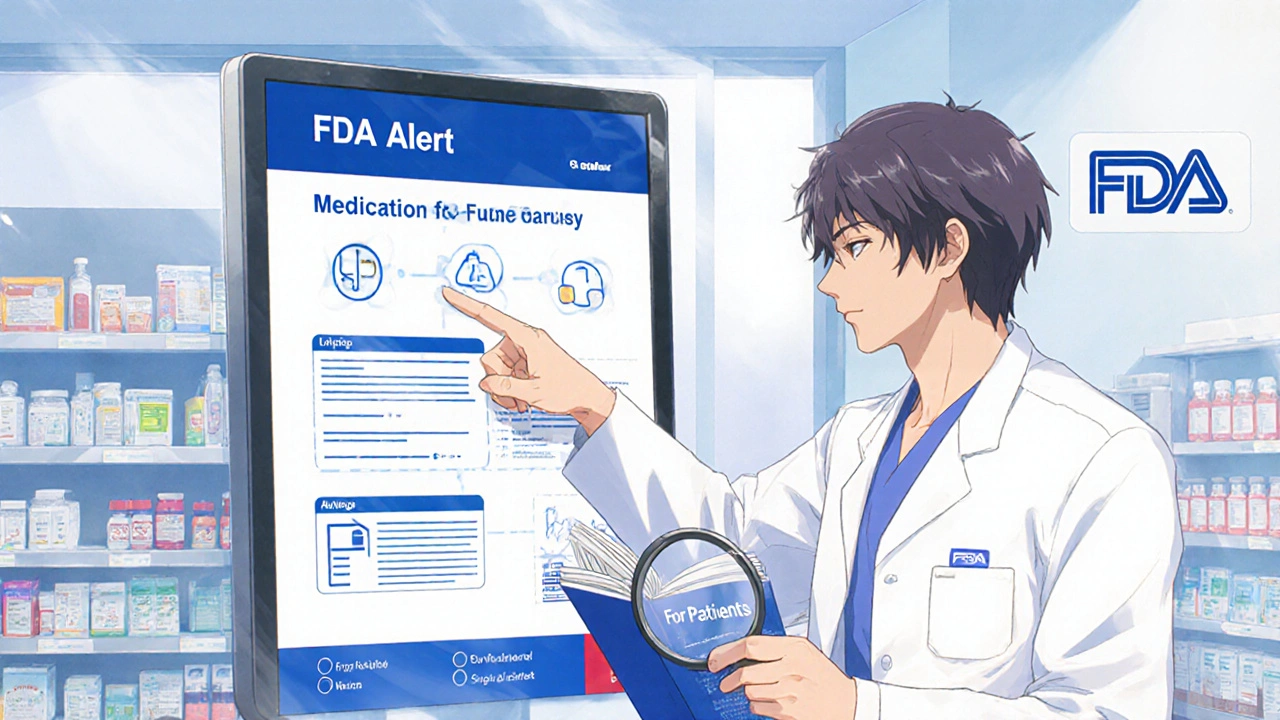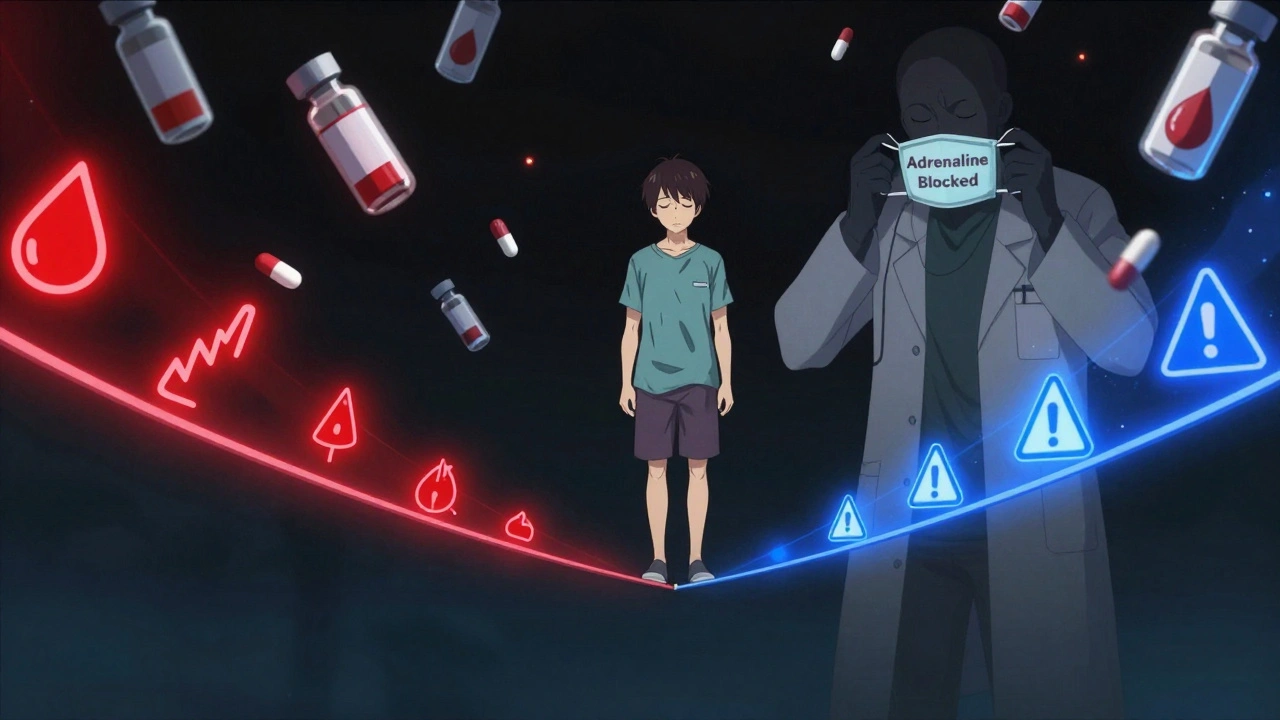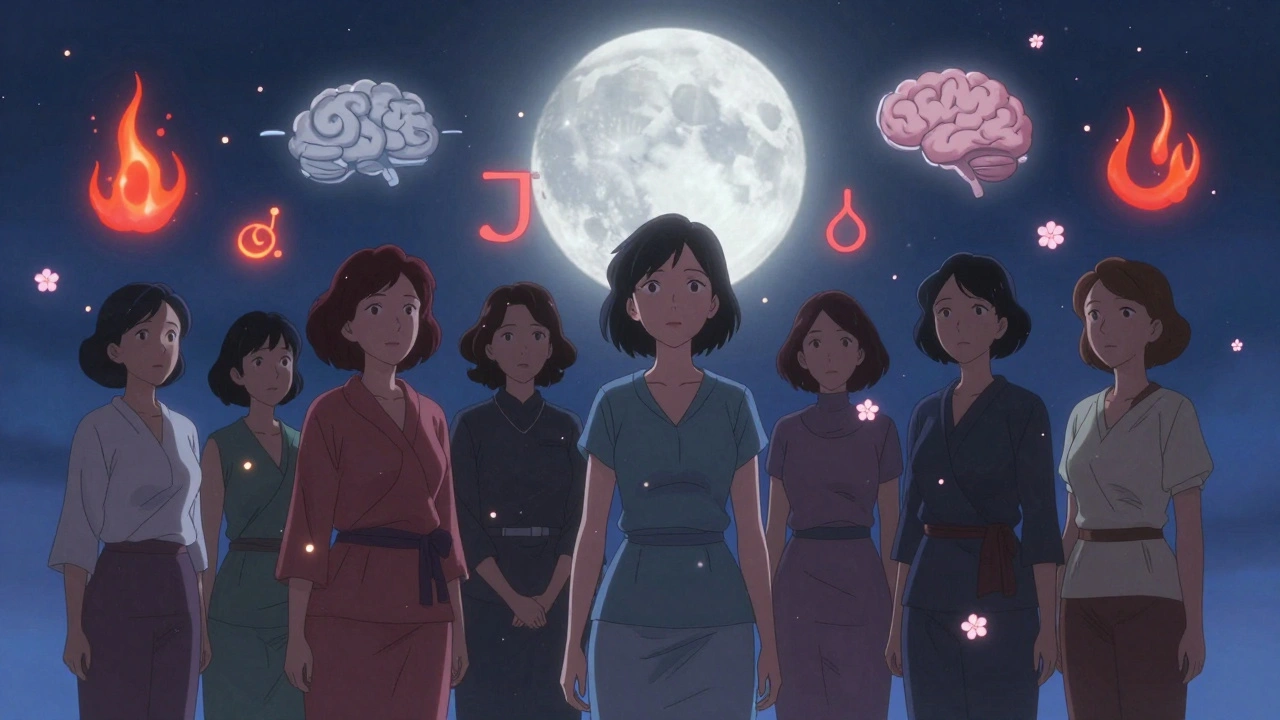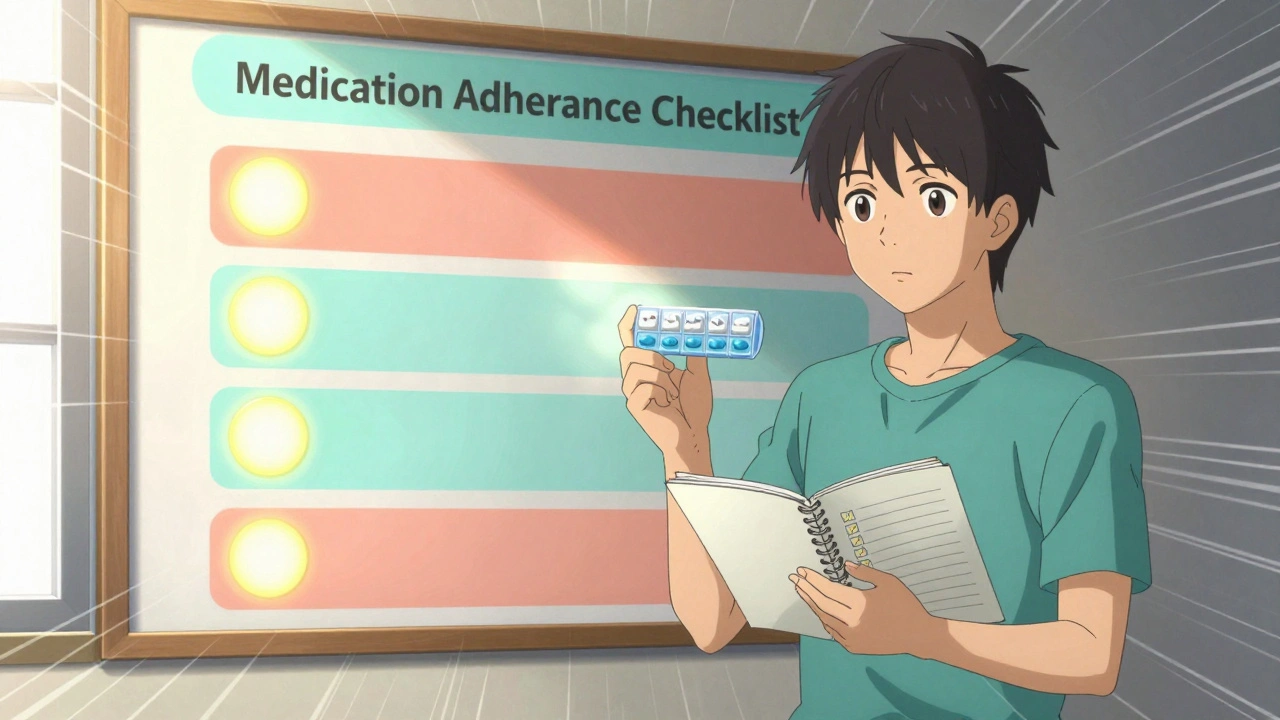How to Read FDA Safety Communications for Your Medications

When you pick up a prescription, you expect it to help you-not hurt you. But drugs don’t stay the same after they’re approved. New risks can show up months or even years later. That’s where FDA Safety Communications come in. These aren’t ads or press releases. They’re official notices from the U.S. Food and Drug Administration telling doctors and patients about serious, newly discovered dangers tied to medications already on the market. If you’re taking any prescription drug, knowing how to read these alerts could protect your health.
What Exactly Are FDA Safety Communications?
These are formal updates issued by the FDA when new safety data emerges after a drug has been approved. Think of them as a post-market safety check. Just because a drug passed clinical trials doesn’t mean all its risks were visible then. Real-world use-thousands or millions of people taking it over time-can uncover rare side effects, dangerous interactions, or misuse patterns that didn’t show up in smaller studies. The FDA started expanding these communications after 2007, giving itself stronger legal power to monitor drugs after they’re sold. Today, they issue 50 to 70 major safety alerts each year. Some are urgent. Others are updates. But all matter. They’re not the same as a recall. A recall means the drug is pulled from shelves. A safety communication means: here’s what we now know, and here’s what you should do.How to Spot the Key Parts of a Safety Communication
FDA communications follow a strict format. If you learn to scan them quickly, you’ll find the info you need in under five minutes. Here’s what to look for:- What Safety Concern Is FDA Announcing? This is the headline. It tells you the problem in plain language. Example: “FDA warns of serious liver injury linked to drug X.”
- Boxed Warning (also called a “Black Box Warning”) is the FDA’s strongest alert. It appears at the top of the prescribing info and highlights life-threatening risks. If this section changed, it’s serious.
- For Health Care Professionals gives doctors specific instructions: adjust dosing, avoid use in certain patients, run tests, etc.
- For Patients is written in simple language. It tells you what to do-like “Talk to your doctor before stopping this medicine” or “Watch for these symptoms.”
- Labeling Changes shows exact text changes in the official prescribing document. Changes are marked in bold for additions and strikethrough for deletions. This is technical, but if you see a change in “Dosage and Administration” or “Warnings,” it’s important.
Don’t get lost in the fine print. Start with the “For Patients” section. If it says something like “Do not stop taking this medicine suddenly,” that’s your cue to call your doctor.
What Do the Different Types of Alerts Mean?
The FDA uses several types of safety notices. Not all are equal:- Drug Safety Communications are the most detailed. These are full reports with data, labeling changes, and recommendations. These are the ones you should read closely.
- Drug Alerts are shorter, often for urgent issues like contamination or sudden risk spikes. They say “STOP” or “CALL YOUR DOCTOR NOW.” Don’t ignore these.
- Labeling Changes are updates to the official drug guide. These might not be urgent but still affect how the drug is used.
- Recalls mean the product is unsafe to use and should be returned. These are rare but critical.
- Compounding Risk Alerts warn about drugs made in special labs (not mass-produced). These can be riskier due to inconsistent quality.
If you see “Boxed Warning” or “contraindicated” in the communication, that’s a red flag. If it says “consider” or “monitor,” it’s more of a heads-up.

How to Know If It Applies to Your Medication
Not every alert affects every drug in a class. Some are specific to one brand. Others apply to all drugs in a group. For example, in 2025, the FDA updated safety info for all opioid painkillers-morphine, oxycodone, hydrocodone-about how to safely reduce doses. That’s a class-wide change. But a warning about a rare liver issue might only apply to one brand-name drug. Check the drug’s generic and brand names in the communication. If your pill is listed, read the full alert. If it’s not mentioned, you’re likely not affected.Still unsure? Look at the “Highlights of Prescribing Information” section. It summarizes the biggest changes in plain terms. It’s designed for quick reading.
What Should You Do When You See an Alert?
Don’t panic. Don’t stop your medicine cold. Here’s what to do step by step:- Find the “For Patients” section. It’s usually near the end. Read it word for word.
- Check if your drug is named. If yes, note the exact risk mentioned.
- Look for action steps. Does it say “contact your doctor”? “Don’t stop”? “Watch for X symptom”?
- Read the Medication Guide. Every prescription comes with one. It’s required by law to be written at an 8th-grade reading level and highlight serious risks. If you don’t have it, ask your pharmacist for a copy.
- Call your doctor or pharmacist. Don’t guess. Ask: “Does this alert affect my medicine? Should I change anything?”
Many patients stop their meds because they’re scared. But stopping suddenly can be dangerous-especially for antidepressants, seizure meds, or heart drugs. Your provider needs to guide you.
How to Stay Updated Without Overwhelming Yourself
You don’t need to check the FDA website every day. Here’s how to make it manageable:- Sign up for email alerts. Go to fda.gov/drugs/drug-safety-and-availability and subscribe. You can filter by drug class-like “opioids” or “diabetes drugs”-so you only get alerts about what you take.
- Ask your pharmacy to notify you. Many pharmacies now flag safety alerts when you refill a prescription. Ask if they do this.
- Check your Medication Guide every time you refill. The FDA requires pharmacies to give you a new one with each fill. That’s because warnings can change.
- Use the FDA’s “Drugs@FDA” database. Search your drug name there to see its full prescribing info and latest labeling changes.
Most doctors don’t read every alert. A 2021 study found only 37% of primary care doctors read full FDA communications. But if you’re informed, you can ask the right questions.

Common Mistakes People Make
Here’s what goes wrong when people misunderstand these alerts:- Confusing alerts with recalls. An alert doesn’t mean your drug is unsafe to use. It means you need to be aware of a new risk.
- Stopping medicine without talking to a provider. This can cause withdrawal, seizures, or rebound symptoms.
- Assuming all drugs in a class are affected. Always check the exact drug name.
- Ignoring “For Patients” because it’s too short. It’s written for you. The rest is for doctors.
- Believing if it’s not in the news, it’s not important. Most safety alerts never make headlines.
One patient I know stopped her blood thinner after reading a vague alert online. She ended up in the ER with a clot. She didn’t realize the alert didn’t apply to her drug-and she didn’t call her doctor.
What’s Changing in the Future
The FDA is working to make these alerts easier to understand. Since 2023, they’ve been testing plain-language summaries for high-risk drugs, available in both English and Spanish. By 2025, they plan to push personalized alerts directly to patient portals linked to electronic health records. They’re also trying to cut the delay between discovering a risk and issuing a warning. Right now, it takes an average of 4 years. New rules require alerts within 30 days of a major safety decision. Still, progress is slow. Many patients still find the language confusing. That’s why your role matters. If you learn to read these alerts, you’re not just informed-you’re helping protect yourself and others.Are FDA Safety Communications the same as drug recalls?
No. A recall means the drug is pulled from the market because it’s unsafe or contaminated. A safety communication means new risks have been discovered, but the drug can still be used-with changes in how it’s prescribed or monitored. You usually don’t need to return your pills unless a recall is issued.
Do I need to read every FDA alert?
No. Only read alerts for medications you’re currently taking. You can sign up for email alerts filtered by drug class so you only get updates about your specific prescriptions. Don’t waste time reading about drugs you don’t use.
What should I do if my drug has a new boxed warning?
Don’t stop taking it. Call your doctor or pharmacist right away. A boxed warning means serious risks exist-like liver damage, heart problems, or suicidal thoughts-but your provider may be able to manage the risk with monitoring, dose changes, or alternative treatments. Never make changes on your own.
Why do some safety alerts take years to come out?
Drug safety monitoring relies on real-world data, not just clinical trials. Rare side effects only show up after thousands of people use the drug for months or years. The FDA collects reports from doctors, patients, and hospitals. It takes time to analyze patterns and confirm a real risk. New rules now require alerts within 30 days of a final safety decision, but delays still happen for complex cases.
Can I trust the information in the Medication Guide?
Yes. By law, Medication Guides must be written at an 8th-grade reading level, clearly state serious risks, and be reviewed by the FDA. They’re meant for patients. If you don’t understand it, ask your pharmacist to explain it. Don’t assume it’s too technical-it’s supposed to be simple.
Next Steps: What to Do Today
If you take any prescription medication, do this now:- Find your most recent Medication Guide.
- Check the date on it. If it’s more than a year old, ask your pharmacy for the latest version.
- Go to fda.gov/drugs/drug-safety-and-availability and sign up for email alerts for your drug class.
- Write down your drug’s name and generic version. Keep it handy when reading alerts.
- Next time you refill your prescription, ask the pharmacist: “Has there been any new safety info on this drug?”
Knowing how to read FDA Safety Communications doesn’t make you a doctor. But it makes you a smarter, safer patient.






Comments
Vanessa Carpenter
November 26, 2025 AT 21:07Been taking my blood pressure med for 5 years and never knew about these FDA alerts. Just signed up for the email notifications. Seriously, why isn’t this common knowledge? I feel like I’ve been flying blind.
Thanks for laying it out so clearly. I’m gonna check my Medication Guide tonight.
Also, my pharmacy just started flagging alerts when I refill. Small win.
Bea Rose
November 28, 2025 AT 18:45Boxed warnings are not suggestions. They are red flags. Stop ignoring them.
Michael Collier
November 29, 2025 AT 03:40It is imperative that patients understand the distinction between a safety communication and a recall. The former informs, while the latter mandates action. Misinterpretation of this distinction has led to significant clinical harm in numerous documented cases.
Furthermore, the FDA’s recent initiatives toward plain-language summaries represent a commendable advancement in patient-centered communication. Continued implementation of these standards is strongly encouraged.
Shannon Amos
November 29, 2025 AT 11:08So let me get this straight - the government spends billions on drug approvals, then waits 4 years to tell us the thing might kill us? And we’re supposed to be grateful they finally sent an email?
Thanks, FDA. You’re doing God’s work. 🙄
stephen riyo
December 1, 2025 AT 09:35Wait, wait, wait - so you’re telling me I shouldn’t just stop my antidepressant because some website says not to? But what if I feel weird? Like, really weird? Like my brain is melting? I mean, I’ve been on it for 3 years, and I’ve never had a single side effect, so why should I trust some PDF from a government site that looks like it was designed in 1998? And also, my doctor doesn’t even answer my texts, so who am I supposed to ask? I just need someone to tell me what to do, please, I’m scared, I don’t want to die, but I also don’t want to feel like a zombie, I just want to be normal, please help, I don’t know what to do anymore.
Also, I think the FDA should fix their website. It’s ugly.
Wendy Edwards
December 1, 2025 AT 22:18OMG YES THIS. I stopped my thyroid med after reading a scary headline and ended up in the ER with my heart racing. My pharmacist literally yelled at me over the phone. Like, I didn’t even know the alert didn’t apply to me. I just saw ‘thyroid’ and panicked.
Now I check the ‘For Patients’ section first. Always. And I keep a little note in my phone with my meds and their generics. I’m not a doctor, but I’m not dumb either. If you take anything, even birth control or blood pressure, you owe it to yourself to read the damn guide. Seriously. It’s not hard. Just don’t Google it. Go to the source. Your life might depend on it.
Also, I just asked my pharmacist for the latest guide and she gave me one from 2023. I was like, ‘this is old.’ She said ‘oh, sorry’ and printed me the new one. So just ask. Don’t assume.
And yes, I cried reading this post. I’m not sorry.
Jaspreet Kaur
December 2, 2025 AT 19:32The body is a river of chemistry and we are but travelers in its currents. The FDA is not a god, nor a guardian - it is a mirror reflecting the limits of our knowledge. A drug is not safe or dangerous - it is simply what it is, and we must learn to listen to the silence between the warnings.
What we call risk is often the cost of evolution. We do not stop the river because it carries stones. We learn to swim with it.
Still, the guide is a compass. Not the destination. Read it. Then trust your body. Not the algorithm. Not the doctor. Not the FDA. You.
Peace.
Dan Rua
December 3, 2025 AT 12:45This is such a helpful breakdown. I’ve been meaning to learn how to read these for years but never knew where to start. The part about checking the Medication Guide every refill? That’s a game-changer.
Also, I just realized my pharmacy does send alerts - I never checked my email notifications. I’m signing up now. Thanks for the nudge. 🙏
Douglas Fisher
December 5, 2025 AT 06:49There is a critical, often-overlooked gap in patient education: the assumption that ‘if it’s not in the news, it’s not important.’ This is dangerously incorrect. The FDA issues approximately 60 safety communications annually - fewer than 5% ever reach mainstream media. The rest? They’re buried in PDFs, ignored by overworked providers, and missed by patients who believe their doctor will tell them everything.
This is not negligence - it is systemic. We must shift from passive reliance to active vigilance. The burden of safety should not rest solely on clinicians.
Additionally, the Medication Guide is legally mandated for a reason. It is not filler. It is your legal right to this information. If your pharmacist refuses to provide it, file a complaint with the state board of pharmacy. You are not being difficult. You are being responsible.
Albert Guasch
December 6, 2025 AT 08:17From a pharmacovigilance standpoint, the temporal lag between real-world adverse event accumulation and regulatory action remains a structural vulnerability in the post-marketing surveillance paradigm. While the FDA’s 30-day rule for high-priority alerts represents a meaningful operational improvement, the reliance on passive reporting systems (e.g., MedWatch) continues to introduce significant signal-to-noise ratios.
Moreover, the distinction between class-wide and agent-specific safety signals requires granular pharmacokinetic and pharmacodynamic analysis - a level of nuance rarely communicated effectively to non-clinical audiences. Plain-language summaries are a necessary, albeit insufficient, step toward equity in risk literacy.
Recommendation: Integrate real-time safety alerts into EHRs with tiered patient-facing notifications - not as pop-ups, but as structured, context-aware prompts tied to prescription renewals.
Ginger Henderson
December 6, 2025 AT 09:28Wow, this is so… responsible. I mean, who even reads these things? I just take my pills and hope for the best. Also, I think the FDA is just trying to scare us so we buy more meds. Like, ‘oh no, this drug might cause sneezing!’ - next thing you know, they’re selling a $50 nasal spray to fix it.
Also, I don’t trust anything that says ‘boxed warning.’ Sounds like a horror movie.
Bethany Buckley
December 8, 2025 AT 03:32How quaint - a post that assumes patients are rational actors capable of interpreting regulatory documents. The very notion is a neoliberal fantasy. The FDA’s communications are not tools of empowerment; they are performative gestures designed to absolve systemic failures in drug oversight. We are not ‘informed patients’ - we are data points in a capitalist pharmacopoeia.
And yet, you ask us to ‘sign up for alerts’? As if the algorithmic curation of our suffering could ever be a substitute for structural reform.
Also, your ‘Medication Guide’ is written in 8th-grade English because the FDA assumes we are all intellectually compromised. How patronizing.
Meanwhile, the pharmaceutical industry spent $6.5B on lobbying last year. But sure - read the PDF. 🌈
Stephanie Deschenes
December 8, 2025 AT 13:41Thank you for writing this. I’ve been a pharmacist for 18 years and I see patients panic over alerts every day - or ignore them completely. This guide hits the sweet spot: clear, calm, practical.
One thing I’d add: if you’re ever unsure, call your pharmacy. We’re not just the people who hand you pills. We’re trained to interpret these alerts. We can explain what’s real, what’s not, and what to do next - usually in under 2 minutes.
Don’t be shy. We’re here to help.
Cynthia Boen
December 9, 2025 AT 12:16This is just another way for Big Pharma to make us feel guilty for taking medicine. Who cares if a drug causes liver damage? I’m not dying from a pill - I’m dying from stress, poverty, and a broken healthcare system. This post is just distraction porn.
Also, I’ve been on this med for 7 years. No one ever told me about this alert. So now I’m supposed to feel bad? Nah.
Amanda Meyer
December 9, 2025 AT 14:30Interesting. I appreciate the effort to simplify this, but I wonder if the emphasis on individual responsibility distracts from the need for systemic change. Why should patients be expected to monitor drug safety when providers are overwhelmed and regulatory agencies are underfunded?
Still - I’m signing up for the alerts. And I’m going to ask my doctor next visit: ‘What’s your process for staying updated on safety communications?’
Maybe if enough of us ask, they’ll start paying attention too.